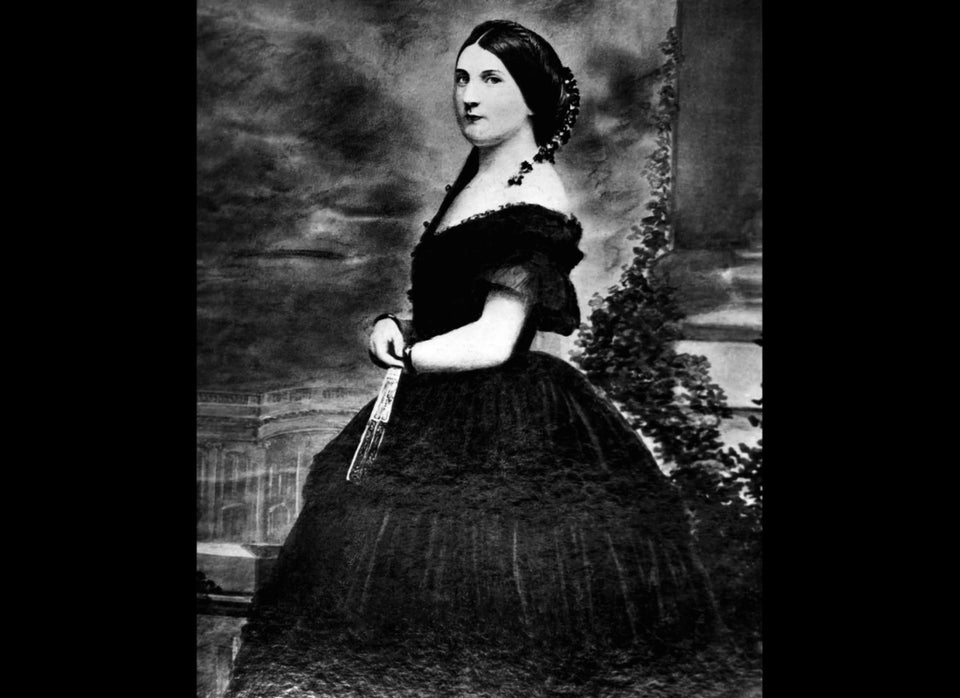
WASHINGTON -- In a city where access equals power, spouses can wield outsized influence. Earlier this year, President Barack Obama cited conversations with his wife, Michelle, as part of the reason he finally affirmed his support for same-sex marriage, describing the watershed change in his public position as "something that we've talked about over the years."
Nancy Reagan, too, is known to have influenced her husband, notably demanding the resignation of White House Chief of Staff Donald Regan in 1987. Even Laura Bush, often considered less outspoken than her husband, wielded her own brand of influence, according to former Secretary of State Condoleezza Rice. "They discuss things," Rice told author Ron Kessler. "If she disagrees, she might roll her eyes or say, 'You don't really think that, do you?'"
The Supreme Court, on the other hand, was initially set up to protect against spousal influence. Starting in 1802, Chief Justice John Marshall required his colleagues to board together in Washington during the court's term. As Justice Ruth Bader Ginsburg told NPR in 2002, "Marshall wanted it that way because he thought that the camaraderie ... would lead to a single opinion for the court."
"He was afraid that if justices lived apart in their own homes, that it would not be as easy ... to rally everyone around one opinion," she said. The boarding setup lasted for more than 25 years.
Toward the end of Marshall's tenure, justices and their wives protested the living arrangements and began moving their families to Washington. But, ultimately, "the chief justice was right," Ginsburg said: Living apart from each other, together with their spouses, the justices reached different conclusions on constitutional matters.
Nearly two centuries later, this dynamic is still at play. One of the most strident Supreme Court disagreements in recent memory came this summer, when Chief Justice John Roberts ruled in favor of President Obama's health care law -- a decision that drew a critical dissent from his fellow conservatives Antonin Scalia, Anthony Kennedy, Clarence Thomas and Samuel Alito.
"Discord at the Supreme Court is deep and personal," CBS News' Jan Crawford wrote following the decision.
While it's impossible to know exactly what swayed Roberts to uphold the law, a source close to the Roberts family, who requested anonymity in order to discuss judicial deliberations, told The Huffington Post that the justice's wife, Jane, exercises a "heavy influence" over her husband.
In Washington, "access is everything," noted journalist and Georgetown hostess Sally Quinn in an interview with HuffPost. "If you want to reach somebody in Washington, the best way to reach them is through their wives."
John and Jane Roberts declined to be interviewed for this story. But Jane's colleagues and friends shared observations about their relationship and what makes them such an unusual couple among the Supreme Court justices.
"They are both very compassionate," said attorney and writer Lisa McElroy, author of the biography "John Roberts: Chief Justice." "Jane is a very intelligent and high-powered lawyer in her own right."
SOCIAL POWER STRUCTURES
The eldest of four siblings, Jane Sullivan Roberts grew up in an Irish Catholic family of modest means in the Bronx during the 1950s. Her father was a mechanic at a post office, and her mother worked as an administrative assistant in a hospital. Jane Roberts got her first job at 15, waitressing at an Ocean City, N.J., restaurant, and has worked almost continuously ever since.
In her commencement address at New England School of Law last year, Roberts told the graduates about her humble upbringing and varied job experiences. "I’ve been a restaurant waitress, a hotel hostess, a car parker, a nurse's aide, a maid in a motel, a bookkeeper and a researcher," she said. "I was an Irish Catholic waitress in a Greek restaurant in a Jewish neighborhood," as well as "a cocktail waitress in a port town near the iron ore mines in far Western Australia."
In 1972, she was part of the first co-ed freshman class at the College of the Holy Cross in Worcester, Mass. After graduating with a degree in mathematics, she spent three years teaching math in Australia before earning a master's degree in applied mathematics from Brown University.
Law school at Georgetown led to a federal appeals court clerkship and eventually a job at Pillsbury Winthrop Shaw Pittman, where she rose to become a partner in the firm's technology practice in the 1990s.
Roberts first met her future husband at a beach house in 1986. "I love to swim and I love the ocean," she told the Worcester Telegram in 2007, "but he was not really quite the beach-goer that I was."
They began dating five years later, while John Roberts was serving as principal deputy solicitor general in George H.W. Bush's administration, and they wed in 1996.
Jane stopped working on legal cases in 2003, when John was appointed to the U.S. Court of Appeals for the D.C. Circuit, in order to avoid any potential conflicts of interest. Instead of aiding clients, she shifted to assisting other lawyers at her firm with career development.
The potential conflicts only increased after her husband was confirmed to the Supreme Court in 2005. "She told me she had to leave the firm when John became chief justice, because it just became untenable," said one of Jane's law school classmates, who requested anonymity because her employer has business before the Supreme Court.
In the spring of 2007, Roberts joined a legal recruiting firm, Major Lindsey & Africa, where she is now a partner. "She told me that she loves it," said her classmate.
John Roberts' confirmation as chief justice meant that he and Jane ascended, practically overnight, to the highest level of Washington's rigid social pecking order. A few weeks after his confirmation, they attended an intimate dinner hosted by President George W. Bush at the White House in honor of Prince Charles and his new wife, Camilla, who were visiting from England.
It was "a magical evening," Jane later told a Holy Cross alumni magazine. It felt, she said, "like the 19th century." Among the highlights was meeting legendary fashion designer Oscar de la Renta. "I used to sew [clothes from] his patterns as a kid," she recalled.
Black-tie evenings in Washington have long been standard fare for Supreme Court justices. Scalia, Alito and Stephen Breyer in particular are known as men about town. "In the old days, they would have been known as the 'dining-out justices,'" said Kevin Chaffee, a veteran journalist and expert on Washington's political and social power structures.
As for their spouses, "Martha-Ann Alito goes out quite a bit, and she's charming," said Chaffee. Indeed, Justice Alito and his wife have been photographed recently at galas for the Washington National Opera, the Shakespeare Theatre Company at Sidney Harman Hall, the National Italian American Foundation and the Holy See.
By contrast, the Roberts generally stick close to their home in Chevy Chase, Md., preferring the company of good friends over the party scene, according to those who know them. Their children, Jack and Josie, are both 12. They attend church as a family, the parents show up to the kids' soccer games, and Jane volunteers for local nonprofits.
Despite their top-flight status within Washington society, "they're both such family people," said Lisa McElroy. "They like to vacation with family, spend weekends with family, and have meals with family."
During the summers, the Roberts settle in at a house on Hupper Island, a remote spot near the village of Port Clyde in St. George, Maine. There, the chief justice and his family enjoy near total privacy, free to go into town for lobster rolls and swim and hike the state's rugged coastline.
Other members of Washington's elite choose more plugged-in vacation spots. The Obamas are fond of Martha's Vineyard, while Sally Quinn spoke to HuffPost from her house in the Hamptons. Justice Breyer and his wife, Joanna, have vacation homes on the Caribbean island of Nevis and in New Hampshire.
The Roberts' low-key lifestyle is likely due in part to the demands of raising two pre-teens while managing their own careers. But it also reflects a broader shift in how Washington society entertains. "There isn't that kind of a social scene there used to be, where you'd always have a Supreme Court justice, an ambassador, a White House person and a journalist" at the same dinner party, Quinn said. "Everyone is in these little pods these days."
"They are big in their neighborhood in Chevy Chase, where all the neighborhood kids know each other," Jane's former classmate said about the Roberts family.
Despite the shifting social landscape, Quinn said that at many Washington events, those seeking to curry favor still overlook the influence that spouses wield. "It's always stunned me at parties that people who are politically ambitious will make a beeline for the person in power," said Quinn, herself the wife of Benjamin Bradlee, former longtime editor of The Washington Post. "People will literally push the spouse out of the way. ... I have women friends all over Washington who joke with me, 'I had on white shoes when I arrived at the party, and now they're black from being trampled!'"
Quinn noted that such tactics have always struck her as counterproductive. "It's foolish to think that a person isn't going to talk to their wife on the drive home," she said.
As power couples increasingly stay closer to home, it's even more likely that spouses influence each other. Powerful Washingtonians "don't go out the way they used to," Quinn said, "so the idea that they wouldn't talk to their spouses becomes more and more absurd."
By all accounts, Jane Roberts and her husband have succeeded at one of the hardest challenges for Supreme Court justices and their spouses: how to be part of the fabric of the nation's capital while simultaneously avoiding the politically charged cocktail circuit.
"The one thing all Supreme Court justices have in common is that they can freeze a person at 20 paces," said Chaffee, the society writer. "Most people can only talk pleasantries with the justices, who all develop a froideur [an air of aloofness]."
"They have enough people who come up and talk about unacceptable topics that they're always ready for that," he explained.
People who know Jane Roberts and her husband, however, say the pressures of the high court have done little to change day-to-day life in their family over the past seven years. "They've been in Washington a long time, and they're really comfortable here," said Jane's former classmate. "Jane is outgoing, and she's more quick to laugh than you might expect. Plus, they also happen to be incredibly nice. He's a doll. He is so sweet."
"I think what's amazing about them is that they've managed to do a really high-quality job of parenting with these incredibly demanding careers," said McElroy, the author.
FIGHTING FOR JUSTICE
Franny Dixwell Holmes, the wife of Justice Oliver Wendell Holmes Jr., observed in 1903 that "Washington is full of famous men and the women they married when they were young."
But the city has changed in the last few decades. Washington's powerful men are now married to women who are their professional and intellectual equals, as is certainly the case with John and Jane Roberts.
Alongside her family and her professional life, Jane Roberts has been actively involved in a half-dozen Washington and Boston area nonprofits over the past decade. They range from Catholic schools and parishioners' groups, to an anti-abortion advocacy group, a hospice, an environmental organization and a professional women's group.
Contrary to what one might imagine for a woman who is under pressure to remain politically neutral, the causes she has championed are not apolitical -- far from it. A wide streak of humanitarianism and concern for society's most vulnerable characterizes Roberts' nonprofit work, priorities that some might consider at odds with today's highly polarized version of political conservatism.
One example of this was Jane Roberts' work on behalf of Feminists for Life, an advocacy group based in Virginia. Roberts served on the group's board from 1995 to 1999 and volunteered as its legal counsel for 12 years, until 2007.
Both Jane and John Roberts are practicing Catholics and have made little secret of their pro-life values. But unlike most mainstream anti-abortion groups, which seek to criminalize the procedure in order to save the unborn, Feminists for Life's goal is to address "the unmet needs of women in the workplace, schools, home and society" -- needs that the group believes are "the root causes that drive women to abortion," according to founder Serrin Foster.
Abortion, Foster wrote in a recent blog post, "hurts the most vulnerable in society -- the poor, the working poor, women in difficult and often abusive relationships, and students and women in the workplace whose basic needs are ignored."
Unlike many other anti-abortion groups, Feminists for Life did not condemn the Supreme Court's June decision to uphold the Affordable Care Act. In a statement on the day of the ruling, the group said it was "pleased" with many of the provisions of the law and simply urged lawmakers to do more to ensure that no abortions would ever be covered by insurance.
Hospice care is another cause to which Jane Roberts has donated her time, through membership on the advisory board of The Washington Home and Community Hospices in 2007 and 2008. Not surprisingly, hospice care providers overwhelmingly support Obama's health care law, which expands patients' end-of-life choices.
Roberts also supports lower energy costs through her service on the board of Citizens for Affordable Energy, a grassroots educational group that former oil executive John Hofmeister founded in 2008. But where the term "affordable energy" is often used by pro-oil-drilling Republicans to attack environmentalist Democrats on Capitol Hill, Hofmeister readily admitted, "I'm a registered Democrat, and my wife was a bundler for Hillary Clinton."
"We're completely nonpartisan," he said in an interview with HuffPost, "but I care deeply about issues that affect the poor, especially what they're paying for energy." Hofmeister is also chairman of the National Urban League, the nation's oldest civil rights and social services organization, but he considers Citizens for Affordable Energy to be his "day job."
Asked about Jane Roberts' role on the group's eight-member board, Hofmeister said, "I can't talk about Jane. You'll have to ask the Supreme Court. But she is a board member and has been there since the beginning."
While Hofmeister believes in expanding all forms of domestic energy production, he insists that he and his organization are coming "entirely from a humane perspective, and the whole thrust for us is affordability."
From this perspective, it's easy to see how Citizens for Affordable Energy fits into the broader portfolio of groups that Jane Roberts supports, all united by concern for "the least among us," whether through increased access to health care, end-of-life choice or affordable energy.
What this might mean for John Roberts on the bench is mere speculation, of course. "He's not the kind of guy to let his personal feelings get in the way of his judicial opinions," said McElroy, "but I can absolutely say they both have strong ethical underpinnings, certainly decency and caring about other people."
Jane Roberts herself put it best when she told the soon-to-be lawyers graduating last year, "Now it's time to put your education, talents and skills at the service of those less fortunate than yourselves. Be generous. It is no accident that so many [of you] go on to careers in public service, fighting for justice for the most vulnerable members of our society. You understand what it means to be men and women for others, and to give back as much as you can."

